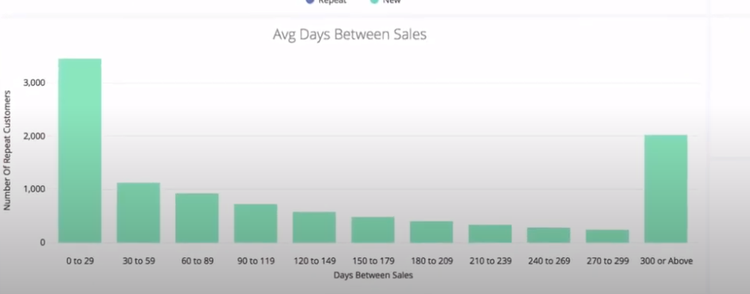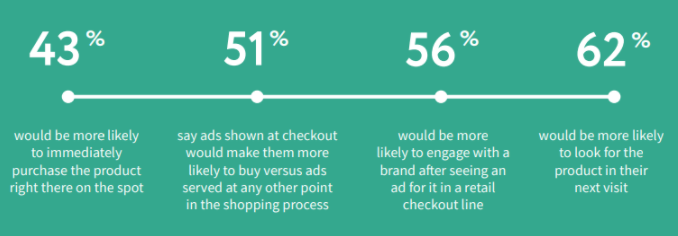Are you using point-of-sale (POS) and point-of-purchase (POP) marketing to your advantage? Both boost your sales and brand awareness. But, POS and POP displays also support upselling, cross-selling, and online brand recognition.
Explore the differences between POS and POP, then use these tips to put your in-store displays to work.
What is POP?
The point of purchase, or POP, is part of the buyer journey where shoppers are considering a purchase but haven't made it to your store checkout line yet. Business owners use POP marketing, like catchy seasonal displays or interactive digital screens, to inform consumers about the benefits of a product or showcase a great deal.
For example, your seasonal mailer may highlight specialty items perfect for the upcoming holidays. In your store, you place these items at eye level in a convenient and accessible place with eye-catching signage. Point of purchase displays include end-of-aisle features and product bins.
What is POS?
At the point of sale, or POS, your customers are ready to buy. They're standing in your checkout line and are more prone to pick up impulse or add-on items.
Many people are familiar with POS systems, software, and hardware that business owners use to complete transactions. But at the POS, you also have incredible opportunities to boost customer spend.
POS marketing, like POP, relies on attractive and easy-to-reach displays. But, your point of sale items may be at your checkout counter or strategically placed in floor units near the cash register.
POP vs. POS: What's the difference?
The main difference between POP and POS is where your customers are in the buying process. POP marketing refers to a phase where customers haven't purchased a product yet. They may be looking for deals on shipping or coupons to lower the price. Or they may need more information about how the product will help them or make their life better.
Once your customer decides to buy a product, then they move into the POS stage. Here they pay for products and get a receipt. As customers stand in line to make a purchase, you may use POS displays to boost your total sales or add information on your ticket that encourages a repeat purchase in exchange for something.
For example, many retailers take advantage of POS features to put a website link or quick response (QR) code on a receipt, so consumers can get a coupon for giving a review, signing up for a loyalty program, or sharing their email address.
5 tips and tricks to effectively use a POP and POS
All POP and POS displays benefit from uncrowded spaces with easy access, lower price points, and visually appealing signs. Depending on your storefront, you may use counter, freestanding or floor bins, or end-of-aisle displays.
Yet, your POS and POP marketing efforts do more than boost sales. They enhance the shopping experience while increasing repeat and online purchases. Use your POS cloud software and these techniques to amplify your promotions with creative displays.
1. Use customer data to optimize POP and POS displays
Effective marketing combines new promotions and displays surrounded by complementary items. So, how often do customers shop at your store? And what products do shoppers buy together? Knowing the answers to these two questions helps you implement an efficient sales strategy and design powerful displays.
Start by looking at your POS system reports. For instance, a Lightspeed POS system offers a "Commonly Bought Together Report." Run this report to discover what items people typically buy together in your store.
Grocers excel at this technique because they target specific shoppers based on what they're buying. A floor to ceiling display with pre-filled balloons in the birthday card aisle suits customers picking up a quick present before attending a party. However, shoppers buying cake mixes find hanging displays with unfilled balloons, birthday candles, and do-it-yourself cake decorations.

Update POP displays based on how often your customers visit your store. Image source: Author
POS reporting features also give you customer metrics. Run reports to see how often a returning customer visits your store. Doing so shows you how often to change your point-of-sale displays and promotions.
2. Deliver an interactive experience
From ripping away a coupon in the store aisle to trying out a lipstick sample, people appreciate trying before buying. Getting consumers to interact with your products or staff increases engagement levels and the probability of purchase or returning to your store.
Many big-name companies do this well by giving away free samples, placing mirrors next to sunglass displays, or encouraging sales teams to suggestively sell related items next to a dressing room or sample area.
Other ways to create immersive in-store experiences with POP or POS displays include:
- Make displays photo-ready: Design signs or backdrops perfect for Instagram photo opportunities. Don't forget to add a branded hashtag and encourage shoppers to tag your store in their photos.
- Add digital information centers: Help shoppers get a great deal, find similar items, or watch your product in action simply by scanning a barcode at your mobile unit.
- Delight all five senses: Create displays that encourage interaction and deliver a complete experience using sound, sight, smell, touch, and taste.
- Deliver mobile in-store coupons. Use customer data to suggest products using a smartphone app, because “49% of shoppers made impulse buys after receiving a personalized recommendation,” according to a Segment survey.
3. Apply POP marketing concepts to increase repeat visits
Getting customers back in your store is key to profitability. And your POP displays encourage repeat visits, with 62% of shoppers saying "they would be more likely to look for a product advertised at the point of purchase on a future visit," according to a Popspots survey.

Buyers say POP and POS displays influence buying decisions. Image source: Author
Consider a promotion plan that starts with a creative in-store product display. Follow it up with a coupon or POP advertisement that encourages customers to visit your store and make a purchase.
Your customers are already familiar with the item, as they remember your unique display. Now, you give shoppers a second look and an incentive to buy.
4. Leverage digital displays to enhance online sales
Digital displays are a great way to delight customers while they're in your store, but interactive visuals also support your digital marketing activities.
A study by Neuro-Insight for Ocean Outdoor finds digital out-of-home (DOOH) "primes the brain to respond more strongly when the same content is viewed online." Furthermore, "full-motion DOOH is 2.5 times more impactful than static out of home (OOH) sites."
So what kind of digital displays attract the most attention? Think about the content that drives online brand awareness, like viral TikTok videos showing five ways to wear the same sweater or how to use an eyebrow pencil to transform your workday look for a night out.
Take advantage of digital displays by connecting them to your POS software. Doing so allows you to quickly make changes based on POS inventory data or the time of day.
5. Create displays to match POP promotions
Are you offering a discount for purchases over a certain amount? Add POP or POS signage near the checkout area so shoppers can quickly grab a few items to increase their order total.
Bath & Body Works finesses this trick well. The company places little baskets of hand sanitizers or lotions on the counter. So when your total comes up short for a discount, you don't have to search the store. You just grab a few items from the counter and get your discount.
For this to be effective, look at your POS data to discover your average total purchase. Then create a promotion that's a few dollars more than common order totals. Place a display next to the counter. Program a pop-up message into your POS terminal to remind your sales team to encourage customers to grab an add-on item for extra savings.
POP vs. POS: Use both to improve customer experience
POS and POP merchandising tactics increase revenue while supporting your shopper’s journey. Design enticing displays using customer data, engagement techniques, and compelling imagery to boost brand awareness and drive repeat visits.
Our Small Business Expert
We're firm believers in the Golden Rule, which is why editorial opinions are ours alone and have not been previously reviewed, approved, or endorsed by included advertisers. The Ascent does not cover all offers on the market. Editorial content from The Ascent is separate from The Motley Fool editorial content and is created by a different analyst team.